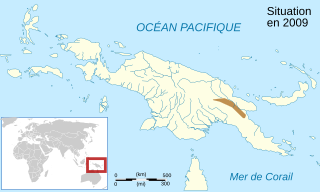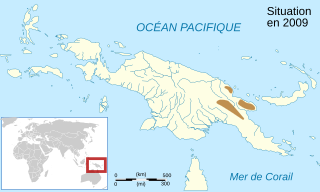
Arthroleptis francei is a species of frog in the family Arthroleptidae. It is found in Mount Mulanje in southern Malawi and in Mount Namuli and Mount Mabu in northern Mozambique. Records from the Zomba Massif (Malawi) require confirmation. Common names Ruo River screeching frog and France's squeaker have been coined for it.
Ranoidea brongersmai is a species of frog in the subfamily Pelodryadinae. It is endemic to New Guinea and known from its type locality in the Snow Mountains, and according to the IUCN Red List of Threatened Species, from another location in the Wapoga River headwaters some 100 km further west. Both sites are in Western New Guinea (Indonesia). Its range is probably broader than current knowledge suggests. The specific name brongersmai honours Leo Brongersma, a Dutch author and zoologist. Accordingly, the common name Brongersma's treefrog has been proposed for it.
The eastern mountains tree frog is a species of frog in the subfamily Pelodryadinae. It is endemic to Papua New Guinea. Its natural habitats are subtropical or tropical moist montane forests and rivers.
The Kassam tree frog is a species of frog in the subfamily Pelodryadinae, endemic to Papua New Guinea. Its natural habitats are subtropical or tropical moist montane forests, rivers, and heavily degraded former forests. It is threatened by habitat loss.
The Baliem River Valley tree frog is a species of frog in the subfamily Pelodryadinae, endemic to West Papua, Indonesia. Its natural habitats are subtropical or tropical high-altitude grassland, freshwater marshes, and rural gardens.
Leptopelis yaldeni is a species of frog in the family Arthroleptidae. It is endemic to Ethiopia and occurs in the montane highlands in Gojjam. Its range might be limited by the deep gorges of the Blue Nile. It is named in honour of Derek Yalden, a British zoologist who collected some of the types. Common names Yalden's tree frog and grassland forest treefrog have been coined for this species.
Choerophryne darlingtoni is a species of frog in the family Microhylidae. It is endemic to Papua New Guinea and found in the New Guinea Highlands. The specific name darlingtoni honors P. Jackson Darlington Jr., an American evolutionary biologist and zoogeographer. Common name Darlington's rainforest frog has been coined for it.
Aphantophryne sabini is a species of frog in the family Microhylidae. It is endemic to Papua New Guinea and is only known from the region of its type locality, Myola Guest House in the Owen Stanley Range, Northern Province. The specific name sabini honors Andrew E. Sabin, an American businessman, philanthropist, and environmentalist who joined the expedition during which the holotype of this species was collected. However, its vernacular name Guest House Guinea frog refers to the type locality instead.
Barygenys nana is a species of frog in the family Microhylidae. It is endemic to New Guinea and is known from the mountains of Eastern Highlands and Western Highlands Provinces, Papua New Guinea. The specific name nana refers to the small size of this species. Common name highland Papua frog has been proposed for it.

Callulops stictogaster is a species of frog in the family Microhylidae. It is endemic to New Guinea and occurs in the central mountain ranges of Papua New Guinea in the Western Highlands, Eastern Highlands, Chimbu, and Morobe Provinces. The specific name stictogaster is derived from the Greek stictos (="spotted") and gaster (="belly"). Common name Irumbofoie callulops frog has been proposed for it.
Choerophryne allisoni is a tiny species of frog in the family Microhylidae. It is endemic to Papua New Guinea and only known from its type locality, Mount Sisa in the Southern Highlands Province. The specific name allisoni honours Allen Allison, an American herpetologist. Common name Allison's mountain frog has been coined for this species.
Cophixalus nubicola is a species of frog in the family Microhylidae. It is endemic to Papua New Guinea and only known from its type locality, Mount Michael in the Eastern Highlands Province. The specific name nubicola refers to its cloud-swept habitat. Common name Michael rainforest frog has been coined for this species.

Cophixalus parkeri is a species of frog in the family Microhylidae. It is endemic to Papua New Guinea where it occurs in the central mountainous region between Chimbu and Morobe Provinces. The specific name parkeri presumably honours Hampton Wildman Parker, an English zoologist and herpetologist to whose perusal Arthur Loveridge sent the holotype. Common name Papua rainforest frog has been coined for it.
Cophixalus riparius is a species of frog in the family Microhylidae. It is endemic to Papua New Guinea and occurs in the New Guinea Highlands in Madang, Southern Highlands, and Western Highlands provinces southeastward to the Morobe Province. The specific name riparius refers to the creek-side habitat from which many specimens in the type series were collected. Common name Wilhelm rainforest frog has been coined for this species.

Cophixalus shellyi is a species of frog in the family Microhylidae. It is endemic to Papua New Guinea and occurs in the New Guinea Highlands as well as in the Adelbert Range and on the Huon Peninsula. The specific name shellyi honors Father Otto Schellenberger ("Shelly"), an American missionary and former professor in mathematics who collected the type series.
Copiula alpestris is a species of frog in the family Microhylidae. It is endemic to Papua New Guinea and known from the Western Highlands, Chimbu, and Eastern Highlands Provinces at elevations of 1,800–2,800 m (5,900–9,200 ft) above sea level. The specific name is a Latin adjective meaning "living in high mountains", in reference to its relatively high-altitude habitats. Based on molecular evidence, the species was transferred from Oxydactyla to Copiula in 2016.
Sphenophryne stenodactyla is a species of frog in the family Microhylidae. It is endemic to Papua New Guinea and known from the New Guinea Highlands in the Western Highlands, Chimbu, Eastern Highlands Provinces at elevations between 2,490 and 4,000 m above sea level. The specific name stenodactyla is derived from the Greek words stenos meaning "narrow" and dactylos meaning "digit".
Phrynobatrachus rungwensis is a species of frog in the family Phrynobatrachidae. It is found in southeastern Democratic Republic of the Congo, central and northern Malawi, and east to southern and central Tanzania. It is also expected to occur in northeastern Zambia. Common names Rungwe puddle frog and Rungwe river frog have been coined for it. It is named after Mount Rungwe, its type locality.
Phrynobatrachus ukingensis is a species of frog in the family Phrynobatrachidae. It is recorded in several places in southern and eastern Tanzania and in northern and southern Malawi ; it probably occurs more widely, at least in areas in between the known localities. Common names Ukinga puddle frog and Ukinga river frog have been coined for it.

The spiny tree frog is a species of frog in the family Rhacophoridae. It is endemic to the Philippines and occurs on Mindanao, Leyte, Bohol, and Basilan, possibly wider.





